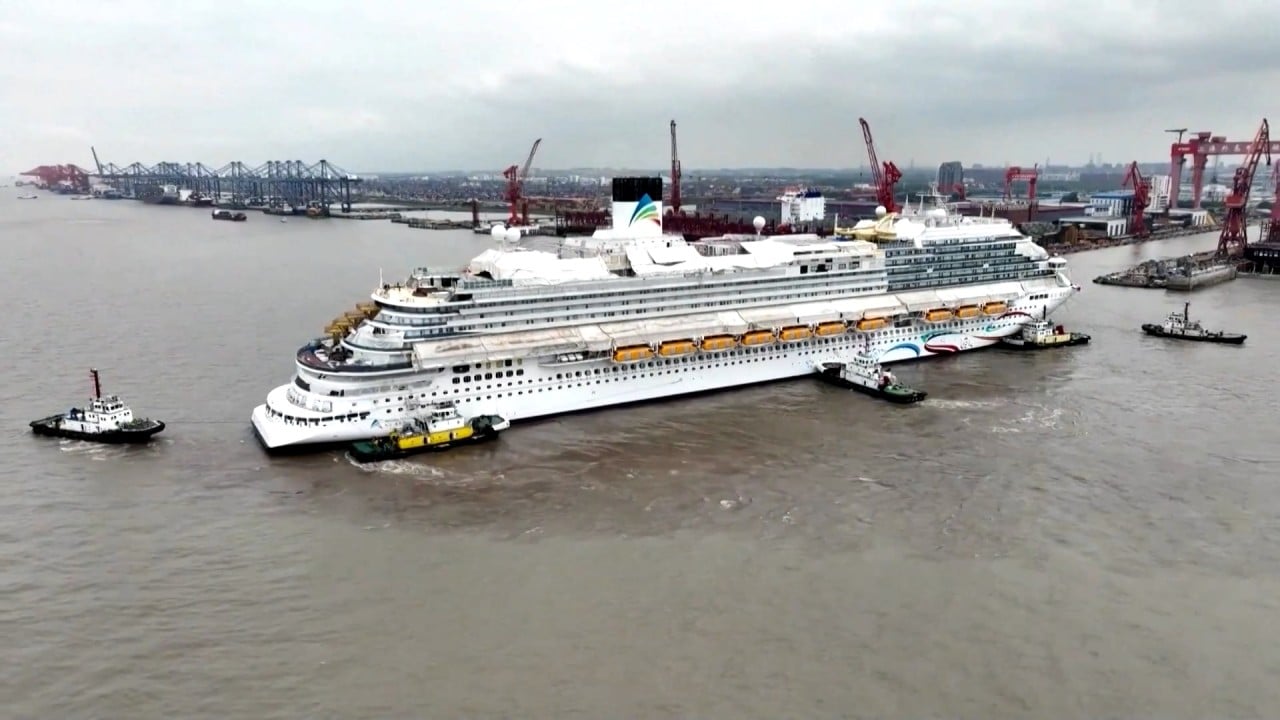China has long maintained a dominant position in the global shipbuilding industry, and it accounted for more than 76 per cent of orders in April, according to British analytics firm Clarksons Research.
It is also making waves in the international cruise industry following the maiden voyage of its first home-grown large cruise liner at the start of this year.
And with its visa-free policies aimed at boosting the number of foreign visitors in the post-Covid era, international cruise passengers are allowed to remain in China for up to 15 days.
How do cruises fit into China’s visa-free scheme?
In May, it was confirmed that foreign visitors arriving via international cruises could stay in China for up to 15 days without a visa.
The new regulations allow foreigners travelling in tour groups of at least two people to enter China visa-free through all 13 cruise ports.
Large international cruises had already started to return to China this year, with Germany’s TUI Cruises having brought 10,000 tourists to China between February and April, according to Shi Zeyi, deputy director of the International Exchange and Cooperation Bureau under China’s Ministry of Culture and Tourism.
China’s National Immigration Administration said in August that, from January to July, 17.254 million foreigners had entered China, representing a year-on-year increase of 129.9 per cent.
The administration added that 846,000 of the arrivals entered on “port visas” – issued on arrival – marking a 182.9 per cent increase compared with the same period last year.
What’s the significance of China’s first home-grown cruise ship?
Upon completion of the Adora Magic City last year, China became the fifth country building large cruise ships, joining Germany, France, Italy and Finland.
After nearly four years of construction, the 135,500-tonne liner built by Shanghai Waigaoqiao Shipbuilding – a subsidiary of the state-owned China State Shipbuilding Corporation – left its dry dock in Shanghai in June last year.
Large cruise ships, most of which have been made by European shipyards, are dubbed one of the “three pearls on the crown of shipbuilding”, with the other two being aircraft carriers and liquefied natural gas vessels, which China already produces.
Adora Magic City, made its maiden voyage in January with over 3,000 passengers stopping at ports on Jeju Island in South Korea, as well as Nagasaki and Fukuoka in Japan.
The ship is also an important part of China’s efforts to boost its high-end manufacturing sector following the expansion of its high-speed railway network and the maiden flight of its first domestically developed narrowbody passenger jet, the C919.
A second domestic cruise ship is already under construction, and it is expected to be delivered before the end of 2026.
Has China’s cruise market recovered in the post-Covid era?
China’s cruise market saw a remarkable 52 per cent average annual growth in passengers embarking from Chinese ports between 2006 and 2019, making it the world’s second-largest cruise market, according to the Cruise Lines International Association.
The outbreak of the coronavirus, though, then halted the cruise industry worldwide.
But in April, after a break of four years, Royal Caribbean and MSC Cruises returned to China’s ports.
And around New Year’s Day, cruise ship bookings increased by 240 per cent, year on year, Ctrip reported.
International and domestic bookings then saw a year-on-year increase of 445 per cent during the Lunar New Year holiday in February, according to Chinese cruise app Fliggy.
In the first half of 2024, China’s cruise market saw a robust recovery, with 206 voyages operated by 23 cruise ships carrying 500,000 passengers.
Passenger turnover returned to about 50 per cent of the level in the same period in 2019, while the second quarter outstripped the first quarter by nearly 60 per cent.
How has China’s economic slowdown affected the cruise ship industry?
Amid the overall economic slowdown, consumers in China have become more price-sensitive.
This has spread to China’s cruise industry, and even with prices being cut, luring customers over the summer proved to be challenging, with tour agencies facing an uphill battle to attract customers eager to make the most of their holiday budgets.
The Adora Magic City luxury cruise package initially cost up to 11,000 yuan (US$1,543).
But an oversupply over the summer led to prices being slashed to between 2,000 yuan and 3,000 yuan.
But even the lower prices failed to attract customers, according to reports from travel agencies amid an unwillingness to spend that has plagued China’s overall economy. The pouring in of investment amid an unwillingness to spend is resulting in an unprecedented competitive landscape for the industry.
Chinese outlets coined this summer a “low peak season”, with a surge coupled with low occupancy rates, which were reportedly as low as 20 per cent.
Royal Caribbean and MSC Cruises have also backed out of their promise to visit Tianjin’s port due to market volatility, which has resulted in price instability.
What’s on the horizon for China’s cruise industry?
Multiple sources have dubbed the next decade China’s second “golden age” in its cruise industry.
The first so-called golden age was from 2013-16, when the industry enjoyed 70 per cent growth every year.
Chinese tourists alone make up 4.9 per cent of worldwide cruise passengers, with 60 per cent having an annual income of over US$94,000, according to data platform Koeeru.
The global cruise tourism market is set to expand from US$7.4 billion in 2023 to US$22.6 billion in 2033, though it is expected to be largely dominated by foreign players, according to the China Cruise and Yacht Industry Association and the Shanghai Academy of Social Sciences.
China’s cruise industry is projected to be worth 550 billion yuan (US$76.8 billion) by 2035, up from US$1.3 billion in 2024.
And it is expected to handle 9 million passengers per year by 2035, Xie Xie, a research fellow with the China Waterborne Transport Research Institute, was quoted by the Global Times as saying in April.
Joint guidelines issued by 10 government agencies, including the Ministry of Transport, aim to grow the Chinese cruise industry into one of the most dynamic markets in the world, with annual passenger trips expected to reach 14 million by 2035.





